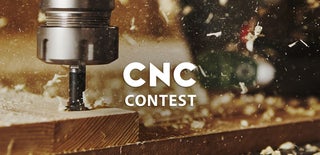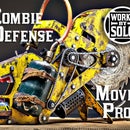Introduction: Building My CNC Circular Saw
The story behind this project and how it came about is explained with a more detail in the YouTube video. Please take a few minutes to watch. You will probably also pick up several nuances that aren't apparent in the still images.
In short, a friend of mine contacted me a couple months ago because he was interested in acquiring some decorative wooden panels that would also diffuse sound, for his recording studio. He knew that I did some fabrication work with my CNC router. After seeing some product samples that were close to what he was looking for, I did some research and determined that the best way to create plywood panels with lots of grooves was to use a saw blade instead of a router bit. I set out to see what I could do to alter my existing CNC machine in my home shop.
My initial inspiration was based on several things, but the biggest spark came from discovering what the designers at Dukta have been developing, https://dukta.com/en/products/ . They pioneered the idea of "flexible plywood". I found many examples of their products, but very little about the process they use to fabricate. To me, the slices in the wood were obviously saw kerfs. With that limited amount of information, I went shopping for a circular saw that I could mount onto my CNC machine.
Supplies
Materials:
• Baltic Birch Plywood: https://amzn.to/2QUx3b8
• Aluminum Plate - http://onlinemetalspartners.go2cloud.org/SF4y
• Mild Steel, 1/2" Round Stock - http://onlinemetalspartners.go2cloud.org/SF4y
Digital Readout (DRO):
• Two Axis DRO with Glass Scales - https://ban.ggood.vip/UxCO
Shop Tools:
• Circular Saw 4-1/2" - https://amzn.to/35FptYS
• Blades 4-1/2" - https://amzn.to/2FpYFkQ
• Table Saw - https://amzn.to/2EMi0vm
• CNC Router - https://www.cncrouterparts.com/
• 14” Deluxe Bandsaw - https://amzn.to/2Vxsnrn
Camera and Video Gear:
• Main Camera - http://amzn.to/2iGbWqP
• Main Lens - http://amzn.to/2zbMboA
• Camera Frame - http://amzn.to/2mRPzmX
• Secondary Camera - http://amzn.to/2Bav3B7
• Tripod - http://amzn.to/2hLnRTu
• Lighting Setup - http://amzn.to/2hJioMT
• Magic Arm A - http://amzn.to/2hKvSIq
• Magic Arm B - http://amzn.to/2Bd3NC3
• Video Monitor - http://amzn.to/2zWoJ1T
• Mic - http://amzn.to/2iEucAY
Step 1: Finding the Right Saw for the Job
Well, I'm not much of a woodworker. The only circular saw I have is an old cheap handyman model that I purchased 30+ years ago. So, I went shopping to see what was now available, with the possibility of being modified to mount onto my CNC machine, in place of the router motor.
Lucky for me, I found a mini (4-1/2") trim saw that was on clearance at a local store.
I've always been the type of person that reads the instructions and safety precautions, but in this case I knew that none of that information was going to apply!
Step 2: Stripping It Down
While I was still in the store, I took a quick look at the chassis of the tool. The one thing that I noticed was that there were five screws holding the gearbox together. The heads were recessed, but I imagined that I could somehow use those to mount the saw to the Z-axis of the CNC machine.
The bottom plate and blade guard had to go, and I needed to come up with a way to hold the power trigger in the "ON" position. A regular zip tie would work good for that.
Step 3: There Were a Few Difficulties
I don't use my spring clip pliers very often, but I'm so happy that I have them when they are needed. Having straight slender punches are handy for knocking out roll pins.
I've never seen anything like the strange spring fastener that held the blade guard in place. I took me a while to figure that one out!
Step 4: My Assumptions Were Correct!
My guess was correct! I kinda' figured that all five of the gearbox screws would be identical, and they were. This is important because that also means that recesses are identical and my fabricated stand-offs can all be the same length. Even more importantly, it means that my mounting plate will be parallel to the blade!
There was one bolt that was used to hold the original bottom plate onto the saw. I couldn't remove it because the head was inside the gearbox. If I left it there, it wouldn't be in the way, so I decided to simply install a nut on it to keep it from rattling around.
Step 5: The Design Work
I shot a few pictures of the saw prior to disassembly, and imported them into my CAD environment. I included a ruler in the photos which allowed me to match it up proportionally with the modeling grid. This made the process of locating the screw holes quite accurate. There are nine holes in all. Five for the gearbox and four for mounting the plate to the CNC.
Step 6: Milling the Base Plate
I pre-cut a chunk of 3/8" thick aluminum plate close to size on the bandsaw, and then trimmed it to final size on the milling machine.
Step 7: The New DRO Made Things Easy!
I used Autodesk Fusion 360 to create dimensioned drawings for the precise hole locations. The drawing module is quite intuitive to use.
My recently installed a digital readout (DRO) on my Bridgeport mill made locating and drilling the holes super easy and accurate. The two axis version works in the X and Y directions.
Step 8: Drilling Operations
I spot drilled first and then through-drilled each hole.
Step 9: A Second Pass for the Counterbores
As a second operation, I went back to each hole location and made a counterbore that was appropriately sized for the cap screw heads. The new DRO made that operation very accurate.
Step 10: Turning the Stand-Offs
Once the mounting plate was finished, I move over to the lathe to turn the stand-offs. They needed to be quite narrow on one end to fit into the recesses in the gearbox cover.
Step 11: A Successful Test Fit!
Taking the time to workout the CAD drawings was well worth it. Everything fit beautifully! I felt confident that this mount was going to strong, but more importantly be secure!
Step 12: A Little Bit of Forethought
By having the photo of the saw in the CAD environment it also allowed me to see where to locate the M8 mounting screws, in order to have clear access to them once the saw was in place. I find that taking a little extra time to think things through can be beneficial.
Step 13: Removing the Router Motor
I hadn't had the router motor off of this machine in about seven years, so there was a little sawdust stuck behind it.
The exact same four M8 bolts and T-nuts from the router mount will be used to attach the saw.
NOTE: These T-nut have a special feature. A ball bearing that prevents them from slipping when inserted in vertical positions. Super helpful!
Step 14: Quick Installation
I plan to swap the router and the saw quite often, so keeping the fasteners the same will help make fast transitions.
Step 15: The Very First Test Cuts!
I know... I know, I built this saw attachment for cutting kerfs, but let's just see what it will do if we drag it sideways! The test results were absolutely amazing!
WHOA! Almost perfectly dished circular cuts! This really gets me thinking about a lot more possibilities.
Step 16: Getting Fancy!
I created some experimental vector paths, and then modeled a rough simulation. The actual saw cuts were slightly different from the model, but close enough to give a good guess as to what the final pattern would look like. The possibilities are endless!
Step 17: Testing More Pattern Cuts
Here is another version with different vectors. Notice the very minimal tool marks!
Step 18: FAILURE!: First Dado Stack
After I did several carving tests it was time to build the dado stack. (Rather, the DIY dado)
My first version involved four saw blades with brass bushings between them to make a dado kerf that was 1/4" wide. It failed. The brass was soft and slippery. After only one mishap, they were destroyed.
Step 19: New and Improved!
My second version includes five identical blades, no spacers, and a steel arbor. I have now used it successfully several times. It's a solid performer.
I have also come up with a better way to mount the plywood stock more securely, so that it stays put and doesn't lift as the saw cuts through.
Step 20: My First Successful Finished Piece!
This was such a fun project and a HUGE learning experience. I just couldn't wait make something with my new machine attachment!
Once I had the feel of how to make proportional cuts that would allow the proper flexibility, I moved forward with my very first real application. A Mid Century Modern Lamp!
See the steps below for links to the YouTube video and Instructable.
Step 21: My First Finished CNC Circular Saw Project!
If you're interested in seeing what I made with this new contraption, check out this YouTube video and the Instructable that goes along with it. Right HERE!
Step 22: Checkout the YouTube Video!

First Prize in the
CNC Contest 2020













